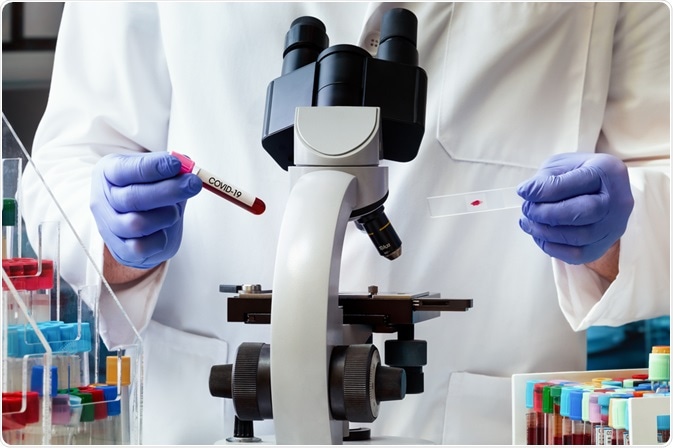Seroprevalence studies of coronavirus disease 2019 (COVID-19) offer insight into how effectively the virus is being contained. Seroprevalence studies have been conducted across the globe. This article contains a summary of some of this research and what the findings can tell us about stopping the spread of the virus throughout the global population.
 Image Credit: angellodeco/Shutterstock.com
Image Credit: angellodeco/Shutterstock.com
COVID-19 is an illness caused by severe acute respiratory syndrome coronavirus 2 (SARS-CoV-2), a zoonotic virus first identified in December 2019. The virus spread globally causing a pandemic and several seroepidemiologic investigations have been conducted to understand the spread of asymptomatic and subclinical infections in the general population.
Seroprevalence studies can offer insight into how effective containment strategies, such as social distancing and quarantines, are at reducing transmission rates.
Global seroprevalence in the first peak of COVID-19
Many seroprevalence studies conducted across the world have shown that the number of undiagnosed, missing cases is probably greater than confirmed cases.
In a study published in the JAMA of Internal Medicine, investigators collected serum samples from 16,025 geographically diverse individuals in the United States between March 23 through May 2020. There was no evidence of antibodies to SARS-CoV-2 in most specimens. The adjusted estimates of the percentage of people who were seroreactive to the spike protein antibodies of SARS-CoV-2 were between 1.0% in people from San Francisco to 6.9% in people from New York City.
The study also found that the estimated number of COVID-19 infections was between 6 to 24 times higher than the number of reported cases at this time. According to the researchers, their results may be explained by individuals who had mild disease or no symptoms who did not seek medical attention or undergo testing. These people, however, likely contribute to a viral transmission.
In another cross-sectional study from Korea, researchers tested the seroprevalence of anti-SARS-CoV-2 antibodies in outpatients. The goal of the study was to understand the burden of COVID-19 as well as the level of herd immunity in this population. In total, the study included 1,500 serum samples which were obtained from outpatients who attended two hospitals between May 25 and May 29 in southwestern Seoul, Korea.
Using electrochemiluminescence immunoassay to detect immunoglobulin G (IgG), among other antibodies, against SARS-CoV-2, the investigators found an overall 0.07% anti-SARS-CoV-2 antibody seropositivity. According to the researchers, this low seroprevalence indicated that the pandemic, at least in certain regions in Korea, was under control via its social distancing and contact tracing programs in place.
Another Korean study, conducted in Daegu, Korea, estimated that the seroprevalence in that region was 7.6% between May 25 to June 5. The study also tested serum samples for IgG from 103 patients and 95 guardians without a confirmed COVID-19 diagnosis. No difference was found between patients and guardians in terms of seroprevalence. The investigators concluded that, based on their estimated figure, the number of missing cases in the region was likely 12 times more than the number of PCR-confirmed COVID-19 cases.
A Spanish study of more than 60,000 participants found a nationwide seroprevalence of approximately 5.0% to 6.2%. Urban areas surrounding Madrid had an estimated seroprevalence of 13.6%, which was reflected by PCR-confirmed cases showing much higher COVID-19 prevalence in urban compared with rural areas.
In a rapid communication study published in European Surveillance, researchers from Germany tested the seroprevalence of IgG antibodies against SARS-CoV-2 in 3,186 blood donors from three German states between March and June 2020. The seroprevalence rate ranged from 0.66% to 1.22%. The investigators noted since most COVID-19 cases are generally mild or asymptomatic, many cases remain recorded. Despite this suggestion, the researchers did not provide an estimated seroprevalence rate in the studied German population.
Limited data is available on the seroprevalence of COVID-19 in healthcare workers. European research has investigated the seroprevalence of COVID-19 antibodies in cleaning and oncological staff at clinics. Strict hygiene is crucial for specialized health wards, particularly during the pandemic, to prevent the shedding of COVID-19 among vulnerable patients.
In one study, researchers from Germany measured antibody titers against COVID-19, including IgG and immunoglobulin A (IgA), in samples from 45 hospital cleaning staff and 20 members of the hospital’s oncology ward. Samples were obtained between June 15 and June 30. There were significantly increased levels of IgA antibody titers in 1 person each in the cleaning staff and the oncology ward. Only 1 person from the oncology ward had significantly elevated IgG antibody titers.
All swabs taking for virus detection came back negative. Despite the lower seroprevalence in this group, the investigators suggest that monitoring hospital cleaning staff may be a “blind spot” in most surveillance programs. Stricter surveillance in this population, they argue, is needed. A similar study from Croatia found that the SARS-CoV-2 seroprevalence is low among healthcare workers in the country.
 Image Credit: Lightspring/Shutterstock.com
Image Credit: Lightspring/Shutterstock.com
Seroprevalence in the second peak
By the end of the first wave of the pandemic had petered in Europe, seroprevalence studies showed that around 1 in 10 people had been infected with the virus. A Geneva-based seroprevalence study aimed to compare seroprevalence after the first and second peaks.
The study suggested that although seroprevalence doubled in its population after the end of the first peak, the majority of its population still remained unexposed, including a very large proportion of vulnerable people at high mortality risk. The researchers suggest that this data is evidence for the continued need to control and prevent the spread of COVID-19.
Case studies like Manaus, Brazil showed that high seroprevalence did not prevent resurging COVID cases. After an initial epidemic in Brazil around April-July, seroprevalence studies indicated that 76% of the population had experienced SARS-CoV-2 infection by October 2020.
This was above the theoretical herd immunity threshold (thought then to be around 67%, taking different factors into account). However, there has been another severe peak of infection in Manaus accelerating from December 2021 to the present (March 2021). There are a number of potential explanations for this including the strain originating in Manaus and short-term immunity (antibodies from COVID-19 infection are thought to last around 5 months), but the takeaway is that it showed natural herd immunity was not a viable option.
What does this tell us about herd immunity
Based on findings like those from these studies, many scientists, clinical researchers, governing bodies and organizations including the World Health Organization have said that proposed approaches to achieve herd immunity, such as through natural infection, were highly unethical and would result in a massive loss of life.
Effective and safe COVID-19 vaccines and therapies are the priority approach of most governing bodies and health organizations for the pandemic. Even though these prevention and treatment options are now receiving approval and rolling out across the world, with millions of people now vaccinated, researchers have noted that seroprevalence studies will still be needed to continue offering information about the duration and extent of vaccine-induced herd immunity.
References
- Eckerle I, Meyer B. SARS-CoV-2 seroprevalence in COVID-19 hotspots. Lancet. 2020;396(10250):514-515. doi:10.1016/S0140-6736(20)31482-3
- Epstude J, Harsch IA. Seroprevalence of COVID-19 antibodies in the cleaning and oncological staff of a municipal clinic. GMS Hyg Infect Control. 2020;15:Doc18. Published 2020 Jul 23. doi:10.3205/dgkh000353
- Havers FP, Reed C, Lim T, et al. Seroprevalence of antibodies to SARS-CoV-2 in 10 Sites in the United States, March 23-May 12, 2020 [published online ahead of print, 2020 Jul 21]. JAMA Intern Med. 2020;10.1001/jamainternmed.2020.4130. doi:10.1001/jamainternmed.2020.4130
- Noh JY, Seo YB, Yoon JG, et al. Seroprevalence of anti-SARS-CoV-2 antibodies among outpatients in Southwestern Seoul, Korea. J Korean Med Sci. 2020;35(33):e311. Published 2020 Aug 24. doi:10.3346/jkms.2020.35.e311
- Pollán M, Pérez-Gómez B, Pastor-Barriuso R, et al. Prevalence of SARS-CoV-2 in Spain (ENE-COVID): a nationwide, population-based seroepidemiological study. Lancet. 2020; published online July 6. https://doi.org/10.1016/ S0140-6736(20)31483-5
- Sabino EC, Buss LF, Carvalho MPS, et al. Resurgence of COVID-19 in Manaus, Brazil, despite high seroprevalence. The Lancet. 2021;397(10273),P452-455. Published 2021 Jan 27. doi:10.1016/S0140-6736(21)00183-5
- Song SK, Lee DH, Nam JH, et al. IgG seroprevalence of COVID-19 among individuals without a history of the coronavirus disease infection in Daegu, Korea. J Korean Med Sci. 2020;35(29):e269. Published 2020 Jul 27. doi:10.3346/jkms.2020.35.e269
- Stringhini S, Zaballa M, Perez-Saes J, et al. Seroprevalence of anti-SARS-CoV-2 antibodies after the second pandemic peak. The Lancet Infectious Diseases. 2021. doi:10.1016/S1473-3099(21)00054-2
- Vilibic-Cavlek T, Stevanovic V, Tabain I, et al. Severe acute respiratory syndrome coronavirus 2 seroprevalence among personnel in the healthcare facilities of Croatia, 2020. Rev Soc Bras Med Trop. 2020;53:e20200458. doi:10.1590/0037-8682-0458-2020
Further Reading
Last Updated: Mar 18, 2021